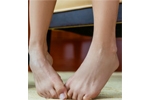If your big toe is starting to look crooked or you have a bump protruding from its base, chances are you have a bunion. In fact, the condition is quite common in women. According to the American Orthopaedic Foot and Ankle Society, about one-third of women in the United States have bunions.
If your big toe is starting to look crooked or you have a bump protruding from its base, chances are you have a bunion. In fact, the condition is quite common in women. According to the American Orthopaedic Foot and Ankle Society, about one-third of women in the United States have bunions.
The technical term for a bunion is “hallux valgus.” It usually appears as a bump on the side of the foot at the base of the big toe. Sometimes the big toe pushes against the toe next to it.
For many people, bunions do not cause pain and are simply a nuisance when it comes to buying footwear. They find that when they wear comfortable, supportive shoes with a low heel and a wide toe box, they rarely experience problems and learn to live with the condition.
However, for some people, bunions are a major problem that diminishes quality of life. Not only is it difficult for them to find comfortable shoes; the bunion causes frequent pain and stiffness around the big toe and they have trouble walking. In some cases, it may lead to arthritis.
Narrow, High-Heeled Shoes and Bunions
Because bunions are 10 times more common in women, we believe the condition may be related to shoe wear. Ultimately, your body will respond to whatever mechanical forces you put on it, so poorly-fitting, tight, pointy high heels may lead to bunions in susceptible individuals. It doesn’t mean that everyone who wears these shoes will develop a bunion; however, the high incidence in women suggests a link. Bunions also tend to run in families, so if a parent has a bunion, you may be at greater risk of the condition.
People who begin to experience pain and stiffness in or around their big toe are advised to look at their footwear. Roomy shoes with a wider toe box can make discomfort less likely and prevent worsening of a bunion. Individuals should never try to force their feet into shoes that don’t fit and should avoid footwear that some women refer to as their “crying shoes” because they may make the condition worse.
It is advisable for all women to minimize the amount of time they spend in high heels that offer little comfort. They can be worn for special events or in the evening, for example, but not as every day shoes because they increase the risk of bunions, as well as a host of other foot problems.
Bunion Symptoms
Bunions can cause a variety of symptoms, including:
- Pain and tenderness around the big toe
- Turning of the big toe toward the adjacent toe or even moving underneath it
- A bony protrusion at the base of the big toe
- Pain and discomfort while walking
- Redness and swelling
- Restricted movement of the big toe
To diagnosis a bunion, the physician should take a detailed medical history to check for diabetes or another condition and perform a physical examination to evaluate the nature of the bunion. X-rays are often ordered to determine damage to the bone and surrounding structures.
Conservative Treatments for Bunions
Most bunions can be treated without surgery. People can take measures to relieve occasional discomfort and to prevent the condition from getting worse. Orthotics have not been found to be useful for people with bunions. Measures that do help include:
- Medications to help alleviate pain and swelling
- Applying ice to reduce inflammation
- Resting the foot and taking it easy if a bunion becomes irritated
- Wearing shoes that are wide in the toe area and do not put pressure on the bunion; you may consider having your shoes stretched
- Using a toe spacer in between the first and second toe to possibly prevent a bunion from getting worse
- Wearing a protective pad in the area of the bunion
When Bunion Surgery is Warranted
I do not believe surgery is warranted for cosmetic reasons alone. However, sometimes conservative treatments fail to provide relief. When the pain is ongoing, patients have difficulty walking despite good shoes, and the bunion appears to be getting worse, people may choose to have surgery.
About 150,000 bunion procedures are performed in the United States each year, and when a highly trained orthopedic foot surgeon performs the surgery, the success rate for pain relief is 90 to 95 percent.
Known as a bunionectomy, the surgery realigns the bone. The goal is to relieve pain and restore the normal position and function of the big toe. Patients receive regional anesthesia and usually leave the hospital the same day they have surgery.
After the procedure, patients are usually off their feet for two weeks. They wear a special shoe for an additional four weeks and can get back to most activities within three months. Patients will be at their best in terms of function within a year.
After surgery, I counsel female patients to wear comfortable shoes and avoid stiletto heels, except for special occasions. A bunion could develop again from poorly-fitting shoes that squeeze and put pressure on the foot.



